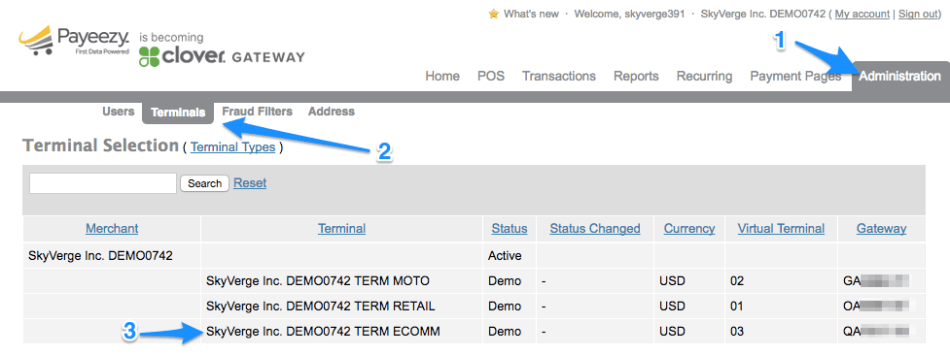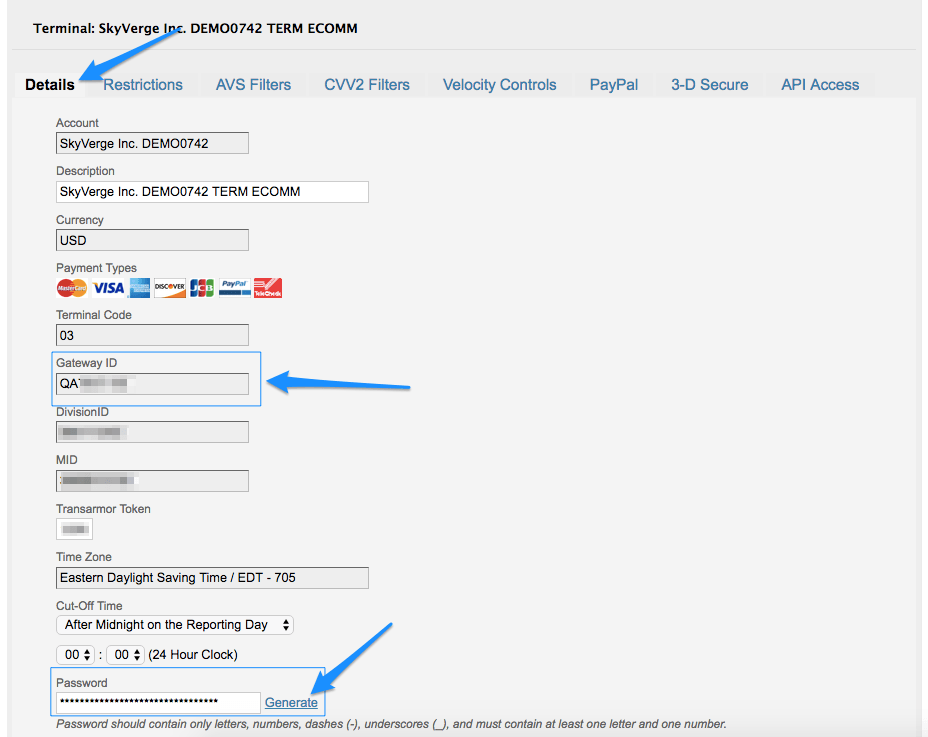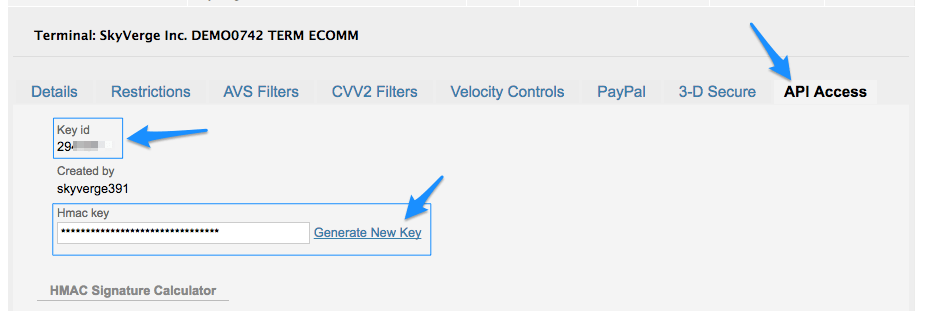Overview
↑ Back to topAs of August 2023, First Data / Fiserv upgraded Payeezy / Global Gateway / GGe4 to Clover Payments (read more about this change here). You do not need to take any action as part of this upgrade and the plugin will continue to work properly. This documentation is no longer maintained. If you need help setting up the Clover integration, please see the documentation here.
For full documentation, please see the plugin documentation here. This document will walk through getting credentials for, and configuring, the Payeezy Gateway mode for the plugin.
Get Account Credentials
↑ Back to top- Log into your Payeezy account and select Administration.
- Go to Terminals and select the “TERM ECOMM” terminal type for your account.

- Under Details, copy your Gateway ID and generate a Gateway Password. Save these values in the plugin’s Connection Settings.

- Under API Access, copy your API Key ID and generate an HMAC Key. Save these values in the plugin’s Connection Settings.

Gateway Settings
↑ Back to topGeneral Settings
↑ Back to top- Enable / Disable – Enable to allow customers to use this gateway to checkout.
- Title – The name of the payment method customers will see during checkout.
- Description – The description of the payment method customers will see during checkout. Limited HTML is allowed.
- Card Verification (CSC) – Enable this to require customers to enter their CVV / CV2 (Card Security Code) when checking out. This can be useful if you have requirements in your First Data account for CV2 verification.
- Transaction Type – This controls how transactions are submitted to First Data. You may choose either “Charge” or “Authorization”. If you select “Authorization”, you must manually capture and settle payments in your First Data control panel or on the WooCommerce orders screen after the transaction has been submitted. This defaults to “Charge”.
- Charge Virtual-Only Orders – (Shown if Transaction Type is set to “Authorization”) Enable this to force charges on order containing only virtual items so they’re captured immediately instead of authorized (for example, to grant download access right away).
- Partial Redemption – This option allows you to capture part of the total amount. For example: if a customer tries to checkout for a $100 order and only has $80 of credit available, the transaction will complete by capturing $80 instead of the full $100.
- Accepted Card Types – This controls the card logos that display during checkout. This is purely cosmetic and has no affect on the cards actually accepted by your merchant account.
- Tokenization – Enable this to allow your customers to securely save their card information to their account for future checkout, or to enable full support for WooCommerce Subscriptions or Pre-Orders. You must configure configure TransArmor Multi-Pay Tokenization before enabling this setting.
- Detailed Decline Messages – Enable to display detailed messages to customers to provide reasoning for declines when possible instead of a generic error message.
- Debug Mode – Enable this if you are having issues correctly processing transactions. You can either log API requests / responses directly to the checkout / thank you page, save them to the WooCommerce Error Log (found under WooCommerce > System Status > Logs) or both. All debugging messages are cleaned of sensitive information before display, but as a best practice, please do not enable this unless you are having issues with the plugin and disable it once your issues are resolved.
- Environment – You can set your site to process transactions in the production or demo environment depending on the type of account you have. If you are not sure, your account is most likely a production account. Make sure that your Gateway credentials match your configured environment.
Connection Settings
↑ Back to top- Share connection settings – Enabling this will allow you to use connection / authentication settings between the credit card and eCheck gateways. If this is enabled, you’ll need to enter First Data gateway credentials under the eCheck settings to process transactions.
- Gateway ID – This is the gateway ID for the currently selected environment. The gateway ID is not the same as your login name. Follow the steps above to find your Gateway ID.
- Gateway Password: This is the gateway password for the currently selected environment. The gateway password is not the same as your account password. Follow the steps above to generate your Gateway Password.
- Key ID – This is the Key used for the enhanced security v12 API authentication for the currently selected environment. Follow the steps above to find your Key ID.
- HMAC Key – This is the HMAC Key used for the enhanced security v12 API authentication for the currently selected environment. Follow the steps above to generate your HMAC Key.
Soft Descriptor Settings
↑ Back to top- Soft Descriptors – Enable this to allow the use of soft descriptors. First Data allows a single merchant account to be used across 150 different websites. This is achieved through the use of “Soft Descriptors”. The soft descriptor allows for a secondary business name, address, and phone to be recorded into the customers credit card transactions. Note that First Data must enable soft descriptors for your merchant account.
Enabling soft descriptors will show additional settings; these settings should reflect the business information for this website.
Additional Documentation
↑ Back to topreturn to the main documentation